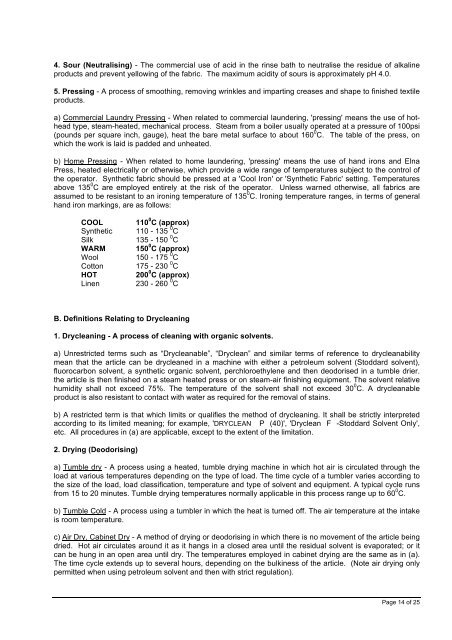international fair claims guide for consumer textiles products
international fair claims guide for consumer textiles products
international fair claims guide for consumer textiles products
Create successful ePaper yourself
Turn your PDF publications into a flip-book with our unique Google optimized e-Paper software.
4. Sour (Neutralising) - The commercial use of acid in the rinse bath to neutralise the residue of alkaline<br />
<strong>products</strong> and prevent yellowing of the fabric. The maximum acidity of sours is approximately pH 4.0.<br />
5. Pressing - A process of smoothing, removing wrinkles and imparting creases and shape to finished textile<br />
<strong>products</strong>.<br />
a) Commercial Laundry Pressing - When related to commercial laundering, 'pressing' means the use of hothead<br />
type, steam-heated, mechanical process. Steam from a boiler usually operated at a pressure of 100psi<br />
(pounds per square inch, gauge), heat the bare metal surface to about 160 0 C. The table of the press, on<br />
which the work is laid is padded and unheated.<br />
b) Home Pressing - When related to home laundering, 'pressing' means the use of hand irons and Elna<br />
Press, heated electrically or otherwise, which provide a wide range of temperatures subject to the control of<br />
the operator. Synthetic fabric should be pressed at a 'Cool Iron' or 'Synthetic Fabric' setting. Temperatures<br />
above 135 0 C are employed entirely at the risk of the operator. Unless warned otherwise, all fabrics are<br />
assumed to be resistant to an ironing temperature of 135 0 C. Ironing temperature ranges, in terms of general<br />
hand iron markings, are as follows:<br />
COOL 110 0 C (approx)<br />
Synthetic 110 - 135 0 C<br />
Silk 135 - 150 0 C<br />
WARM 150 0 C (approx)<br />
Wool 150 - 175 0 C<br />
Cotton 175 - 230 0 C<br />
HOT 200 0 C (approx)<br />
Linen 230 - 260 0 C<br />
B. Definitions Relating to Drycleaning<br />
1. Drycleaning - A process of cleaning with organic solvents.<br />
a) Unrestricted terms such as “Drycleanable”, “Dryclean” and similar terms of reference to drycleanability<br />
mean that the article can be drycleaned in a machine with either a petroleum solvent (Stoddard solvent),<br />
fluorocarbon solvent, a synthetic organic solvent, perchloroethylene and then deodorised in a tumble drier.<br />
the article is then finished on a steam heated press or on steam-air finishing equipment. The solvent relative<br />
humidity shall not exceed 75%. The temperature of the solvent shall not exceed 30 0 C. A drycleanable<br />
product is also resistant to contact with water as required <strong>for</strong> the removal of stains.<br />
b) A restricted term is that which limits or qualifies the method of drycleaning. It shall be strictly interpreted<br />
according to its limited meaning; <strong>for</strong> example, 'DRYCLEAN P (40)', 'Dryclean F -Stoddard Solvent Only',<br />
etc. All procedures in (a) are applicable, except to the extent of the limitation.<br />
2. Drying (Deodorising)<br />
a) Tumble dry - A process using a heated, tumble drying machine in which hot air is circulated through the<br />
load at various temperatures depending on the type of load. The time cycle of a tumbler varies according to<br />
the size of the load, load classification, temperature and type of solvent and equipment. A typical cycle runs<br />
from 15 to 20 minutes. Tumble drying temperatures normally applicable in this process range up to 60 0 C.<br />
b) Tumble Cold - A process using a tumbler in which the heat is turned off. The air temperature at the intake<br />
is room temperature.<br />
c) Air Dry, Cabinet Dry - A method of drying or deodorising in which there is no movement of the article being<br />
dried. Hot air circulates around it as it hangs in a closed area until the residual solvent is evaporated; or it<br />
can be hung in an open area until dry. The temperatures employed in cabinet drying are the same as in (a).<br />
The time cycle extends up to several hours, depending on the bulkiness of the article. (Note air drying only<br />
permitted when using petroleum solvent and then with strict regulation).<br />
Page 14 of 25


